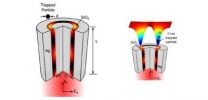(Press-News.org) The population of the United States is getting older, due not only to aging boomers but also to a four-year increase in life expectancy from 1990 to 2010. An aging population means increased diagnosis of prostate cancer. Statistically, the older the patient at time of diagnosis, the more aggressive the disease – and also the less well the patient is likely to tolerate traditional chemotherapies. In sum, we have more, aggressive prostate cancer that can't be targeted by traditional treatments.
Members of the University of Colorado Cancer Center recently published a review in the journal Drugs and Aging describing the modern state of prostate cancer care – examining not only new drugs but entirely new classes of drugs that may be effective and well-tolerated in these aging patients.
"For patients with advanced prostate cancer, there are more options than ever before. But with more options comes a more complex decision tree in choosing appropriate therapies," says Elizabeth Kessler, MD, oncology fellow at the University of Colorado Cancer Center and the review's lead author.
First among these options are targeted therapies. Modern targeted therapies are able to selectively kill cancer cells as opposed to accepting high collateral damage in healthy tissue and so frequently have fewer side effects than traditional chemotherapies. (And are thus better tolerated by elderly patients.)
"These are drugs like abiraterone and enzalutamide that have been approved for use in late stage prostate cancer and are now being evaluated for earlier use," Kessler says. Prostate cancer generally depends on androgen hormones like testosterone to survive and grow – even after traditional hormone blockade, the body continues to produce minute amounts of testosterone and even this little bit is enough to drive prostate cancer. By completely removing the body's ability to produce testosterone or the cancer's ability to use it, these drugs break the messaging chain that tells prostate cancer to grow. CU Cancer Center researchers have played an important role in the clinical development of both of these drugs.
Researchers are also looking for additional, molecular drivers of prostate cancer, perhaps for example insulin growth factor.
"We're also exploring the use of targeted kinase inhibitors," Kessler says. For example, the drug known as XL184 by Exelixis is currently in clinical trials to target MET and VEGF, "and appears to show effect against bone lesions, the most common location of prostate cancer metastasis," Kessler says.
"Another promising strategy to treat metastatic prostate cancer is immunotherapy," Kessler says. In immunotherapy, drugs, devices or treatments are used to sensitize the body's immune system to attack cancer cells – boosting the body's ability to clear itself of cancer. For example, the drug Sipuleucel-T was approved by the FDA in 2010 for treatment of metastatic prostate cancer – "but it requires blood to be removed, treated, and reinfused," Kessler says – a procedure that can only be accomplished by shipping the patient's blood to facilities in other cities before reinfusing it here. Second generation prostate cancer immunotherapies including Prostvac are in development or clinical trials, including an open trial at the CU Cancer Center.
Finally, researchers are exploring ultra-precise targeting of radiation that rides along with drugs that attach to bone metastases and affects only the tumor cells in the immediate areas of attachment. "One of these drugs is Alpharadin," Kessler says, "which goes only shallowly into bone and so targets lesions without stopping the production of bone marrow."
"There has been a major shift in the acceptance of these drugs," Kessler says. "We're learning to reach for them sooner and more frequently in place of traditional chemotherapies."
This shift means that just as boomers pass age 65 – the most common time of prostate cancer diagnosis – researchers have a handful of new barriers to put in the path of the disease.
### END
Longer life expectancy, aging population necessitate new strategies for prostate cancer care
New classes of drugs and targeted therapies
2012-12-05
ELSE PRESS RELEASES FROM THIS DATE:
UI researchers help find way to protect historic limestone buildings
2012-12-05
Buildings and statues constructed of limestone can be protected from pollution by applying a thin, single layer of a water-resistant coating.
That's the word from a University of Iowa researcher and her colleagues from Cardiff University in a paper published in the journal Scientific Reports, from the publishers of Nature. In the study, the researchers report a new way to minimize chemical reactions that cause buildings to deteriorate, according to Vicki Grassian, F. Wendell Miller professor in the UI departments of chemistry and chemical and biochemical engineering.
The ...
Are there racial disparities in osteoporosis screening and treatment?
2012-12-05
New Rochelle, NY, December 4, 2012—About 30 million women in the U.S. have osteoporosis, with low bone mass and deteriorating bone structure that increases their risk for fractures. Racial differences in the rates of detection and management of osteoporosis were explored in a study of African American and white women published in Journal of Women's Health, a peer-reviewed publication from Mary Ann Liebert, Inc., publishers. The article is available free on the Journal of Women's Health website at http://www.liebertpub.com/jwh.
The study, "Osteoporosis Health Care Disparities ...
Quantum thermodynamics
2012-12-05
No man is an island, entire of itself, said poet John Donne. And no atom neither. Even in the middle of intergalactic space, atoms feel the electromagnetic field---also known as the cosmic microwave background---left over by the Big Bang. The cosmos is filled with interactions that remind atoms they are not alone. Stray electric fields, say from a nearby electronic device, will also slightly adjust the internal energy levels of atoms, a process called the Stark effect. Even the universal vacuum, presumably empty of any energy or particles, can very briefly muster virtual ...
Hogging the spotlight: South Farms pig gets international attention
2012-12-05
URBANA – A detailed annotation of the genome of T.J. Tabasco, a pig from the University of Illinois South Farms, is the outcome of over 10 years of work by an international consortium. It is expected to speed progress in both biomedical and agricultural research. U of I Vice President for Research Lawrence Schook said that the College of ACES played a crucial role in getting the work started.
Funding that came through ACES allowed Schook and others to put together the Swine Genome Sequencing Consortium, an alliance of university, industry, and government laboratories ...
New optical tweezers trap specimens just a few nanometers across
2012-12-05
To grasp and move microscopic objects, such as bacteria and the components of living cells, scientists can harness the power of concentrated light to manipulate them without ever physically touching them.
Now, doctoral student Amr Saleh and Assistant Professor Jennifer Dionne, researchers at the Stanford School of Engineering, have designed an innovative light aperture that allows them to optically trap smaller objects than ever before – potentially just a few atoms in size.
The process of optical trapping – or optical tweezing, as it is often known – involves sculpting ...
Brain stimulation may buffer feelings of social pain
2012-12-05
Paolo Riva of the University of Milano-Bicocca and colleagues wanted to examine whether there might be a causal relationship between activity in the right ventrolateral prefrontal cortex (rVLPFC) – known to be involved in the regulation of physical pain and negative expressions of emotion – and experiences of social pain. Their findings are published in Psychological Science, a journal of the Association for Psychological Science.
The researchers recruited 79 university students to take part in a "mental visualization exercise." They used a constant-current regulator ...
Antiretroviral treatment for HIV reduces food insecurity, reports AIDS Journal
2012-12-05
Philadelphia, Pa. (December 4, 2012) – Can treatment with modern anti-HIV drugs help fight hunger for HIV-infected patients in Africa? Starting antiretroviral therapy for HIV reduces "food insecurity" among patients in Uganda, suggests a study published online by the journal AIDS, official journal of the International AIDS Society. AIDS is published by Lippincott Williams & Wilkins, a part ofWolters Kluwer Health..
Treatment including antiretroviral therapy (ART) may lead to a "positive feedback loop" whereby improved functioning and productivity lead to increased ability ...
'Transport infrastructure' determines spread of HIV subtypes in Africa
2012-12-05
Philadelphia, Pa. (December 4, 2012) – Road networks and geographic factors affecting "spatial accessibility" have a major impact on the spread of HIV across sub-Saharan Africa, according to a study published online by the journal AIDS, official journal of the International AIDS Society. AIDS is published by Lippincott Williams & Wilkins, a part ofWolters Kluwer Health.
Using sophisticated mapping techniques and detailed databases, Dr Andrew J. Tatem of the University of Florida and colleagues have found "coherent spatial patterns in HIV-1 subtype distributions" across ...
Breath test could possibly diagnose colorectal cancer
2012-12-05
A new study published in BJS has demonstrated for the first time that a simple breath analysis could be used for colorectal cancer screening. The study is part of the "Improving Outcomes in Gastrointestinal Cancer" supplement.
Cancer tissue has different metabolism compared to normal healthy cells and produces some substances which can be detected in the breath of these patients. Analysis of the volatile organic compounds (VOCs) linked to cancer is a new frontier in cancer screening.
Led by Donato F. Altomare, MD, of the Department of Emergency and Organ Transplantation ...
Smoking may worsen hangover after heavy drinking
2012-12-05
PISCATAWAY, NJ – People who like to smoke when they drink may be at greater risk of suffering a hangover the next morning, according to a study in the January 2013 issue of the Journal of Studies on Alcohol and Drugs.
For anyone who has ever had too much to drink, that day-after combination of headache, nausea and fatigue may be a familiar feeling. But some drinkers appear hangover-resistant: about one-quarter of people who drink enough to spur a hangover in most of us don't actually develop one.
No one is sure why that is. But the new study suggests that smoking could ...
LAST 30 PRESS RELEASES:
S-species-stimulated deep reconstruction of ultra-homogeneous CuS nanosheets for efficient HMF electrooxidation
Mechanical and corrosion behavior of additively manufactured NiTi shape memory alloys
New discovery rewrites the rules of antigen presentation
Researchers achieve chain-length control of fatty acid biosynthesis in yeast
Water interactions in molecular sieve catalysis: Framework evolution and reaction modulation
Shark biology breakthrough: Study tracks tiger sharks to Maui mating hub
Mysterious iron ‘bar’ discovered in famous nebula
World-first tool reduces harmful engagement with AI-generated explicit images
Learning about public consensus on climate change does little to boost people’s support for action, study shows
Sylvester Cancer Tip Sheet for January 2026
The Global Ocean Ship-Based Hydrographic Investigations Program (GO-SHIP) receives the Ocean Observing Team Award
Elva Escobar Briones selected for The Oceanography Society Mentoring Award
Why a life-threatening sedative is being prescribed more often for seniors
Findings suggest that certain medications for Type 2 diabetes reduce risk of dementia
UC Riverside scientists win 2025 Buchalter Cosmology Prize
SETI Institute opens call for nominations for the 2026 Tarter Award
Novel theranostic model shows curative potential for gastric and pancreatic tumors
How beige fat keeps blood pressure in check
Fossils reveal ‘latitudinal traps’ that increased extinction risk for marine species
Review: The opportunities and risks of AI in mental health research and care
New map reveals features of Antarctic’s ice-covered landscape
Beige fat promotes healthy vascular function and blood pressure in mice
Chronic low-dose pesticide exposure reduces the life span of wild lake fish, China-based study shows
Tiny earthquakes reveal hidden faults under Northern California
Long-term pesticide exposure accelerates aging and shortens lifespan in fish
Professor Tae-Woo Lee's research group develops groundbreaking perovskite display technology demonstrating the highest efficiency and industry-level operational lifetime
The “broker” family helps tidy up the cell
Ecology: Mummified cheetahs discovery gives hope for species’ Arabic reintroduction
Researchers survey the ADHD coaching boom
Air pollution and cardiac remodeling and function in patients with breast cancer
[Press-News.org] Longer life expectancy, aging population necessitate new strategies for prostate cancer careNew classes of drugs and targeted therapies


